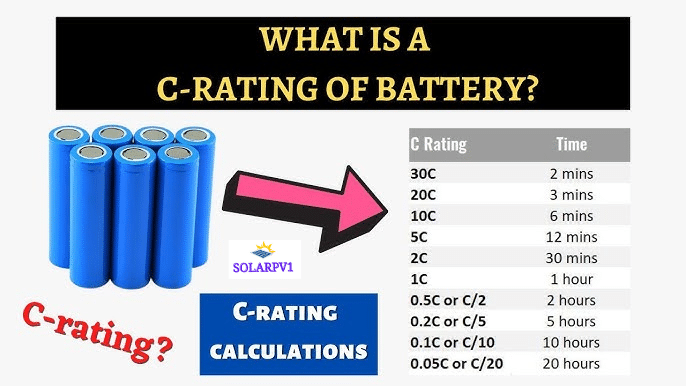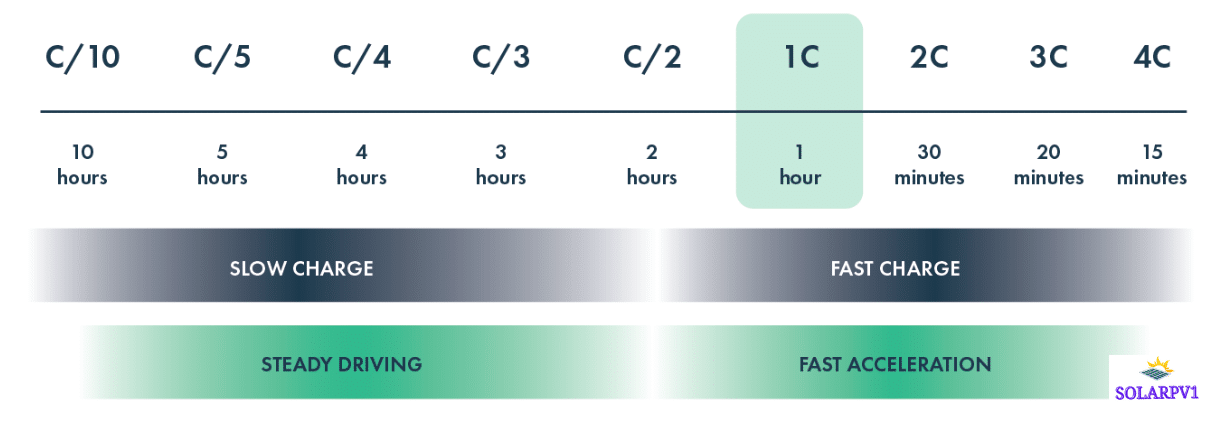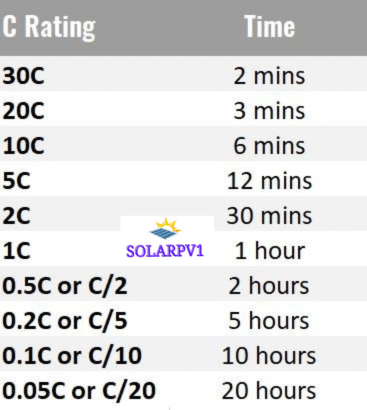Defining C-Rate definition
The term ‘C-Rate’ is a crucial concept in the realm of battery technology, expressing the charge and discharge current of a battery in relation to its capacity. It is defined mathematically as the current (in amperes) divided by the capacity (in ampere-hours) of the battery. For instance, a battery with a capacity of 1 ampere-hour (Ah) being charged at a rate of 1C signifies that it will take approximately one hour to complete a full charge, delivering 1 ampere throughout the charging duration. Conversely, if the same battery is charged or discharged at 0.5C, it implies that the process will take about two hours since the current is halved to 0.5 amperes.
The C-Rate helps in evaluating the performance of batteries across various applications, illustrating how quickly a battery can be charged or discharged safely without causing damage. Higher C-Rates typically indicate faster charging or discharging, which can be advantageous in numerous scenarios, such as in electric vehicles or portable electronics. However, rapid charging can also lead to increased heat generation and potential strain on the battery cells, impacting their longevity and performance if not managed correctly.
Understanding the C-Rate is essential for those involved in selecting or utilizing battery technologies, as it assists in determining the appropriate charging protocols and safety measures needed for different applications. Manufacturers often specify the recommended C-Rates for their products to optimize performance and ensure reliability. In summary, the C-Rate serves as a vital metric for assessing battery capabilities, offering insight into the balance between efficiency, speed, and battery health.
Importance of C-Rate in Battery Performance
The C-Rate is a pivotal factor in determining how a battery performs, significantly influencing its efficiency across diverse applications. This measurement indicates the rate at which a battery is charged or discharged relative to its capacity. For instance, a battery with a capacity of 100 Ah (Amp-hours) charged at a rate of 1C would require one hour to reach full charge. Conversely, if charged at a rate of 2C, it will reach full capacity in half the time. Understanding C-Rate is essential for specific applications, as each application has distinct energy demands.
In the context of electric vehicles (EVs), the C-Rate affects acceleration, range, and the overall driving experience. EV batteries are often subjected to high C-Rates to achieve rapid acceleration without compromising range. On the other hand, consumer electronics, such as smartphones and laptops, typically operate at lower C-Rates to ensure effective energy management without overheating. For renewable energy storage systems, the required C-Rates vary based on energy generation patterns and consumption rates, which directly impacts how well the system can respond to demand fluctuations.
Moreover, the C-Rate plays a critical role in battery longevity. Operating a battery consistently at high C-Rates can lead to faster degradation, while lower C-Rates generally promote longer life cycles. This relationship is also intertwined with safety concerns; a higher C-Rate might generate excess heat during both charging and discharging processes, potentially causing thermal runaway in severe cases. Therefore, understanding the importance of C-Rate in battery performance not only facilitates optimal usage but also informs better design choices, guiding consumers and manufacturers alike toward safer and more efficient energy solutions.
Factors Influencing C-Rate
The C-Rate of a battery, a crucial metric for understanding its charging and discharging behavior, is influenced by several interrelated factors. One of the primary determinants is the chemistry of the battery itself. Different battery types, including Lithium-ion, Lead-acid, and Nickel-metal hydride, exhibit distinct C-Rate characteristics. For instance, Lithium-ion batteries typically support higher C-Rates due to their superior conductivity and energy density. In contrast, Lead-acid batteries often have lower maximum C-Rates, which can limit their use in applications requiring rapid power delivery.
Another significant factor affecting the C-Rate is temperature. The performance of a battery is highly sensitive to thermal conditions; higher temperatures can enhance the chemical reactions within the battery, leading to higher discharge and charge rates. However, excessive heat can also promote degradation, negatively impacting long-term battery health. Conversely, low temperatures may impede reaction kinetics, thereby reducing the effective C-Rate and overall performance.
The state of charge (SOC) of a battery plays a pivotal role in defining its C-Rate. Batteries at lower states of charge may be unable to discharge at high rates without significant voltage drops, whereas those that are fully charged might support higher discharge rates without adverse effects. Additionally, the design of the battery system, including factors such as internal resistance and cell configuration, can influence its C-Rate capabilities.
Moreover, the interactions between these factors can create complex implications for battery performance. For example, a high C-Rate at elevated temperatures may be feasible for Lithium-ion batteries, while the same conditions for Lead-acid batteries can lead to overheating and reduced lifespan. Understanding these dynamics is essential for optimizing battery usage in real-world applications.
Practical Applications and Examples
The concept of C-Rate is pivotal across various industries, influencing the performance and efficiency of battery technologies. One of the most significant applications is in fast-charging technologies, where the ability to charge batteries at a high current rate can drastically reduce downtime. For instance, many electric vehicles (EVs) are designed to accommodate a fast-charging C-Rate, allowing them to recharge significant portions of their battery capacity in a short time. This becomes crucial for users who need their vehicles ready quickly, thereby enhancing the overall utility and appeal of EVs.
Moreover, energy storage systems (ESS) in renewable energy applications exemplify the importance of understanding C-Rate. These systems are essential for storing excess energy generated from sources such as solar panels and wind turbines. By optimizing the C-Rate, these systems can discharge energy efficiently when demand is high and recharge promptly during peak generation times. This not only improves energy management but also contributes to stabilizing the grid, showcasing the necessity of an appropriate C-Rate for performance improvement.
Another compelling example is observed in the specifications of batteries used in consumer electronics. Devices like smartphones and laptops often employ batteries with defined C-Rates to determine charging speeds and discharge performance. Recent case studies reveal that optimizing these C-Rates can lead to advancements in battery life and overall device functionality. Industry leaders have reported that a better understanding of C-Rate can lead to significant innovations, such as batteries that can withstand higher discharge rates without compromising safety or longevity.
Overall, the application of C-Rate spans across multiple fields, underscoring its importance in enhancing the functionality and reliability of battery technologies. Such advancements not only improve user experiences but also foster sustainability within energy systems.










